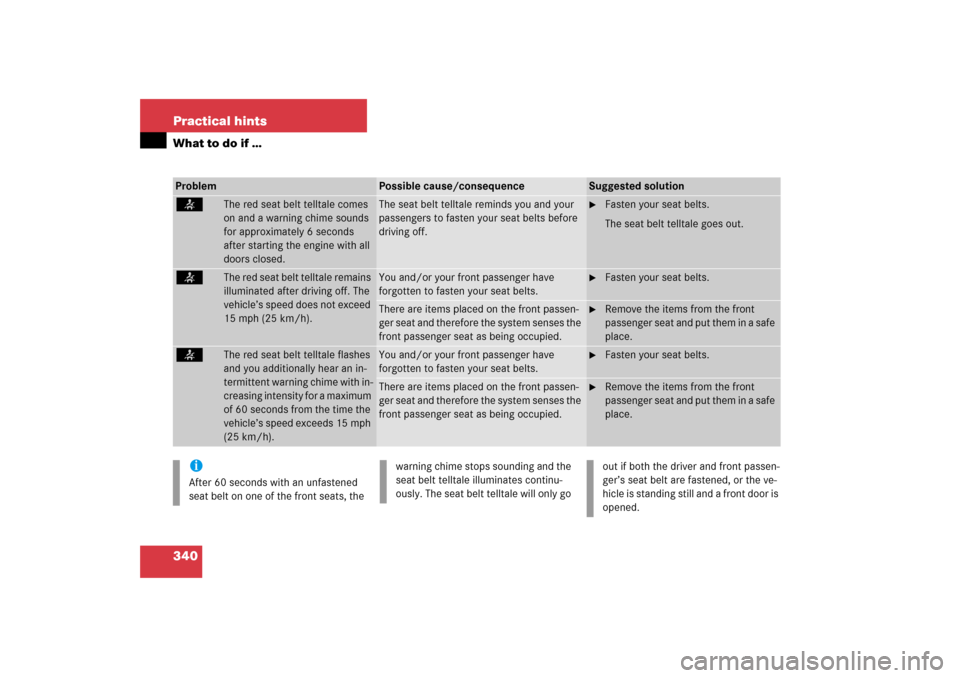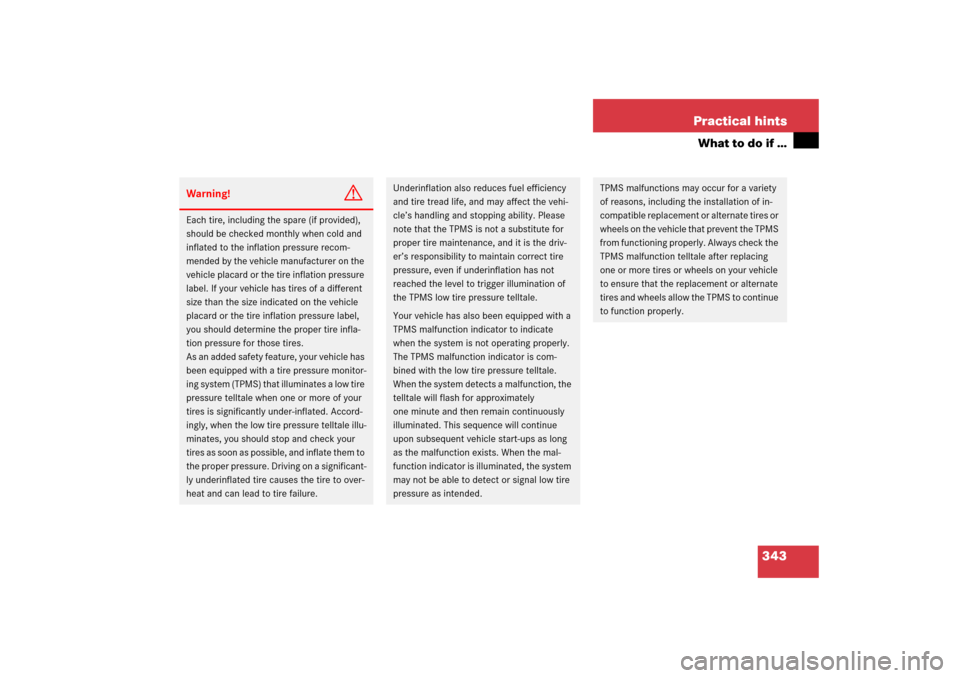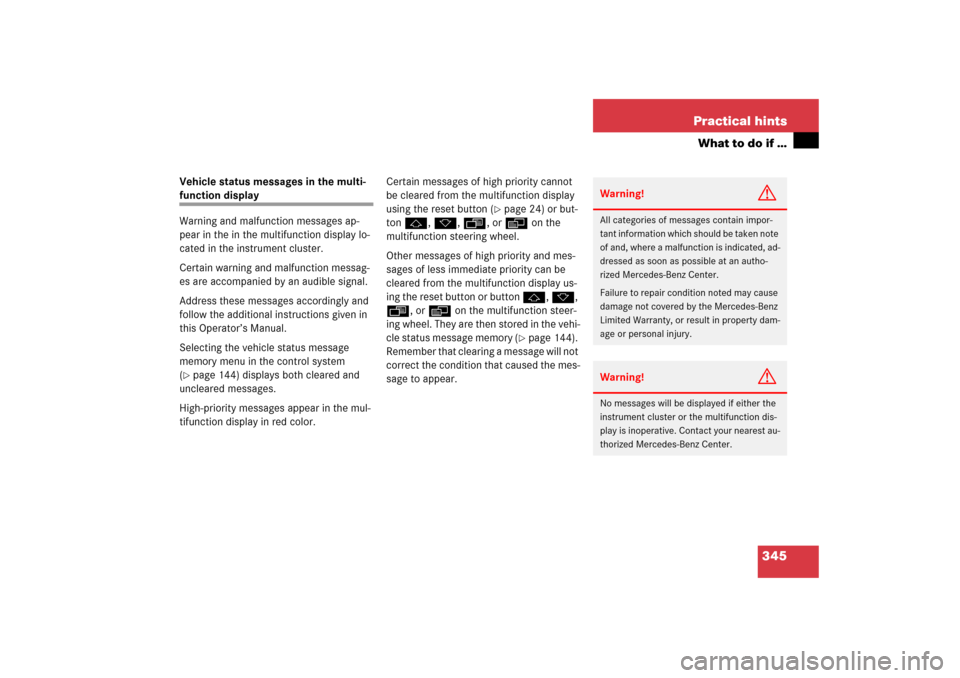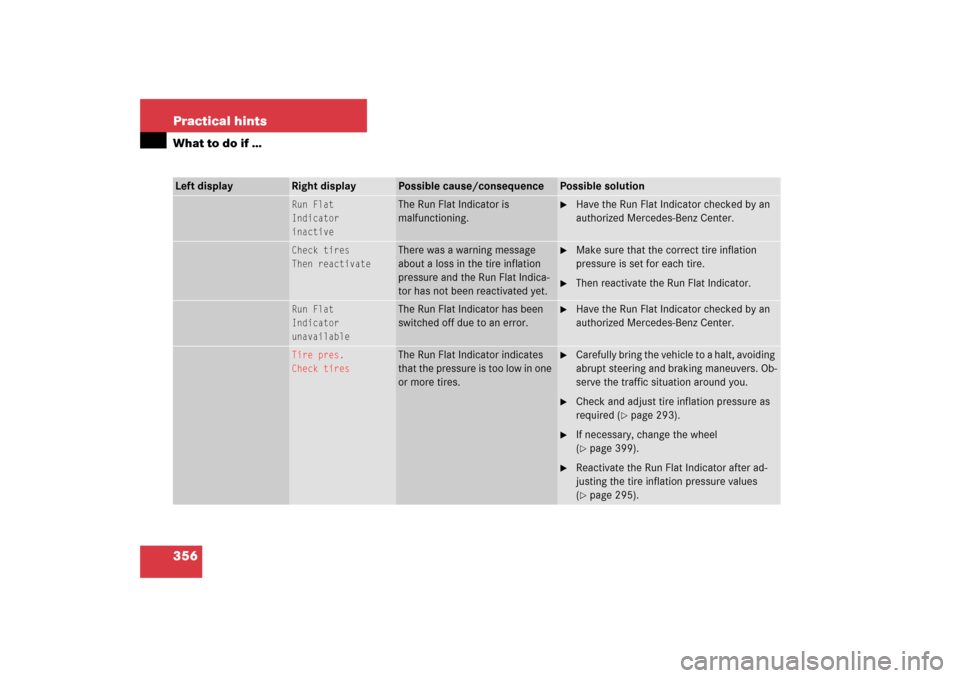Page 341 of 480

340 Practical hintsWhat to do if …Problem
Possible cause/consequence
Suggested solution
<
The red seat belt telltale comes
on and a warning chime sounds
for approximately 6 seconds
after starting the engine with all
doors closed.
The seat belt telltale reminds you and your
passengers to fasten your seat belts before
driving off.
�
Fasten your seat belts.
The seat belt telltale goes out.
<
The red seat belt telltale remains
illuminated after driving off. The
vehicle’s speed does not exceed
15 mph (25 km/h).
You and/or your front passenger have
forgotten to fasten your seat belts.
�
Fasten your seat belts.
There are items placed on the front passen-
ger seat and therefore the system senses the
front passenger seat as being occupied.
�
Remove the items from the front
passenger seat and put them in a safe
place.
<
The red seat belt telltale flashes
and you additionally hear an in-
termittent warning chime with in-
creasing intensity for a maximum
of 60 seconds from the time the
vehicle’s speed exceeds 15 mph
(25 km/h).
You and/or your front passenger have
forgotten to fasten your seat belts.
�
Fasten your seat belts.
There are items placed on the front passen-
ger seat and therefore the system senses the
front passenger seat as being occupied.
�
Remove the items from the front
passenger seat and put them in a safe
place.
iAfter 60 seconds with an unfastened
seat belt on one of the front seats, the
warning chime stops sounding and the
seat belt telltale illuminates continu-
ously. The seat belt telltale will only go
out if both the driver and front passen-
ger’s seat belt are fastened, or the ve-
hicle is standing still and a front door is
opened.
Page 342 of 480
341 Practical hints
What to do if …
Problem
Possible cause/consequence
Suggested solution
1
The red SRS indicator lamp
comes on while driving.
There is a malfunction in the restraint sys-
tems. The airbags or Emergency Tensioning
Devices (ETDs) could deploy unexpectedly or
fail to activate in an accident.
�
Drive with added caution to the near-
est authorized
Mercedes-Benz Center.
Warning!
G
In the event that a malfunction of the SRS is
indicated as outlined above, the SRS may
not be operational. For your safety, we
strongly recommend that you visit an
authorized Mercedes-Benz Center immedi-
ately to have the system checked; otherwise
the SRS may not be activated when needed
in an accident, which could result in serious
or fatal injury, or it might deploy
unexpectedly and unnecessarily which
could also result in an accident and/or
injury to you or to others.
Page 344 of 480

343 Practical hints
What to do if …
Warning!
G
Each tire, including the spare (if provided),
should be checked monthly when cold and
inflated to the inflation pressure recom-
mended by the vehicle manufacturer on the
vehicle placard or the tire inflation pressure
label. If your vehicle has tires of a different
size than the size indicated on the vehicle
placard or the tire inflation pressure label,
you should determine the proper tire infla-
tion pressure for those tires.
As an added safety feature, your vehicle has
been equipped with a tire pressure monitor-
ing system (TPMS) that illuminates a low tire
pressure telltale when one or more of your
tires is significantly under-inflated. Accord-
ingly, when the low tire pressure telltale illu-
minates, you should stop and check your
tires as soon as possible, and inflate them to
the proper pressure. Driving on a significant-
ly underinflated tire causes the tire to over-
heat and can lead to tire failure.
Underinflation also reduces fuel efficiency
and tire tread life, and may affect the vehi-
cle’s handling and stopping ability. Please
note that the TPMS is not a substitute for
proper tire maintenance, and it is the driv-
er’s responsibility to maintain correct tire
pressure, even if underinflation has not
reached the level to trigger illumination of
the TPMS low tire pressure telltale.
Your vehicle has also been equipped with a
TPMS malfunction indicator to indicate
when the system is not operating properly.
The TPMS malfunction indicator is com-
bined with the low tire pressure telltale.
When the system detects a malfunction, the
telltale will flash for approximately
one minute and then remain continuously
illuminated. This sequence will continue
upon subsequent vehicle start-ups as long
as the malfunction exists. When the mal-
function indicator is illuminated, the system
may not be able to detect or signal low tire
pressure as intended.
TPMS malfunctions may occur for a variety
of reasons, including the installation of in-
compatible replacement or alternate tires or
wheels on the vehicle that prevent the TPMS
from functioning properly. Always check the
TPMS malfunction telltale after replacing
one or more tires or wheels on your vehicle
to ensure that the replacement or alternate
tires and wheels allow the TPMS to continue
to function properly.
Page 346 of 480

345 Practical hints
What to do if …
Vehicle status messages in the multi-function display
Warning and malfunction messages ap-
pear in the in the multifunction display lo-
cated in the instrument cluster.
Certain warning and malfunction messag-
es are accompanied by an audible signal.
Address these messages accordingly and
follow the additional instructions given in
this Operator’s Manual.
Selecting the vehicle status message
memory menu in the control system
(�page 144) displays both cleared and
uncleared messages.
High-priority messages appear in the mul-
tifunction display in red color.Certain messages of high priority cannot
be cleared from the multifunction display
using the reset button (
�page 24) or but-
ton j, k, ÿ, or è on the
multifunction steering wheel.
Other messages of high priority and mes-
sages of less immediate priority can be
cleared from the multifunction display us-
ing the reset button or button j, k,
ÿ, or è on the multifunction steer-
ing wheel. They are then stored in the vehi-
cle status message memory (
�page 144).
Remember that clearing a message will not
correct the condition that caused the mes-
sage to appear.
Warning!
G
All categories of messages contain impor-
tant information which should be taken note
of and, where a malfunction is indicated, ad-
dressed as soon as possible at an autho-
rized Mercedes-Benz Center.
Failure to repair condition noted may cause
damage not covered by the Mercedes-Benz
Limited Warranty, or result in property dam-
age or personal injury.Warning!
G
No messages will be displayed if either the
instrument cluster or the multifunction dis-
play is inoperative. Contact your nearest au-
thorized Mercedes-Benz Center.
Page 347 of 480
346 Practical hintsWhat to do if …On the pages that follow, you will find a
compilation of the most important warning
and malfunction messages that may ap-
pear in the multifunction display.
For your convenience the messages are di-
vided into two sections:�
Text messages (
�page 347)
�
Symbol messages (
�page 359)
iSwitching on the ignition causes all in-
strument cluster lamps (except high
beam headlamp indicator lamp and
turn signal indicator lamps unless acti-
vated) as well as the multifunction dis-
play to come on. Make sure the lamps
and the multifunction display are in
working order before starting your jour-
ney.
Page 357 of 480

356 Practical hintsWhat to do if …Left display
Right display
Possible cause/consequence
Possible solution
Run Flat
Indicator
inactive
The Run Flat Indicator is
malfunctioning.
�
Have the Run Flat Indicator checked by an
authorized Mercedes-Benz Center.
Check tires
Then reactivate
There was a warning message
about a loss in the tire inflation
pressure and the Run Flat Indica-
tor has not been reactivated yet.
�
Make sure that the correct tire inflation
pressure is set for each tire.
�
Then reactivate the Run Flat Indicator.
Run Flat
Indicator
unavailable
The Run Flat Indicator has been
switched off due to an error.
�
Have the Run Flat Indicator checked by an
authorized Mercedes-Benz Center.
Tire pres.
Check tires
The Run Flat Indicator indicates
that the pressure is too low in one
or more tires.
�
Carefully bring the vehicle to a halt, avoiding
abrupt steering and braking maneuvers. Ob-
serve the traffic situation around you.
�
Check and adjust tire inflation pressure as
required (
�page 293).
�
If necessary, change the wheel
(�page 399).
�
Reactivate the Run Flat Indicator after ad-
justing the tire inflation pressure values
(�page 295).
Page 359 of 480
358 Practical hintsWhat to do if …Left display
Right display
Possible cause/consequence
Possible solution
Tire pres. monitor
Wheel sensor missing
One or more sensors malfunction
(e.g. battery in one or more wheel
sensor is empty).
One or more wheels without wheel
sensors mounted (e.g. spare tire).
�
Have the TPMS checked by an authorized
Mercedes-Benz Center.
�
Have the wheel sensors installed by an
authorized Mercedes-Benz Center.
Tire pressure monitor
inoperative
The TPMS is malfunctioning.
�
Have the TPMS checked by an authorized
Mercedes-Benz Center.
Warning!
G
Do not drive with a flat tire. A flat tire affects
the ability to steer or brake the vehicle.
You may lose control of the vehicle. Contin-
ued driving with a flat tire will cause exces-
sive heat build-up and possibly a fire.
Page 362 of 480

361 Practical hints
What to do if …
Left display
Right display
Possible cause/consequence
Possible solution
T
Reduced
braking power!
Depress brake
pedal fully!
The electro-hydraulic brake system
is in emergency operation mode.
Considerably greater brake pedal
force is required and the stopping
distance is increased.
The maximum speed is limited to
55 mph (90 km/h).
�
Do not drive any further.
�
Stop the vehicle in a safe location or as soon
as it is safe to do so and notify an authorized
Mercedes-Benz Center.
�
Prevent the vehicle from rolling away by
blocking the wheels with wheel chocks or oth-
er sizable objects.
�
Call for Roadside Assistance.
USA only:;Canada only:3
Reduced
brake effect
Start engine
The battery has insufficient voltage
and cannot supply sufficient power
to the electro-hydraulic brake sys-
tem.
�
Start the engine.
The message disappears when sufficient
voltage is available.
Warning!
G
Inhalation of exhaust gas is hazardous to
your health. All exhaust gas contains carbon
monoxide, and inhaling it can cause uncon-
sciousness and lead to death.
Do not run the engine in confined areas
(such as a garage) which are not properly
ventilated.